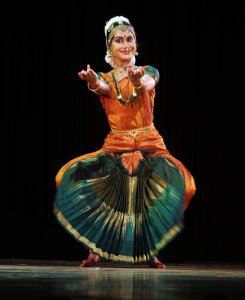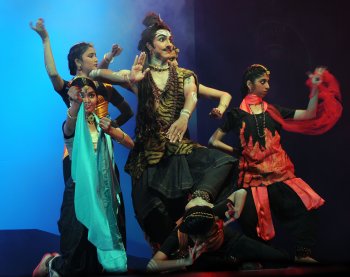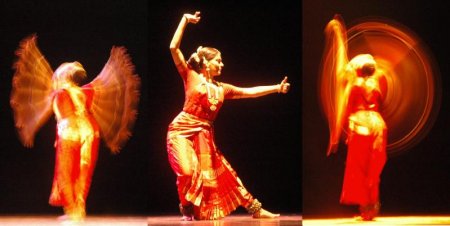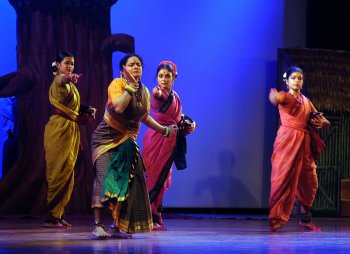
|   |

|   |
e-mail: vs.veejaysai@gmail.com Photos: Thanthoni January 17, 2012 Passionate love of a blinded beauty Suddenly the morning solos seemed to be promising from the fifth day. The sixth day morning’s first performance was a solo dance recital by Aishwayra N Balasubramanian. A student of Anita Guha, Aishwarya has already made a decent name for herself as one of the promising dancers of tomorrow. Opening her performance with a Murugan Kavuthuvam in Shanmukhapriya ragam, Aishwarya showed an initial hesitation and restraint but eventually opened up. She gave her full strength in the Shringara padam “Emoko chigurutadharamula” by Annamacharya. Getting into the character with an affirmation, Aishwarya’s abhinaya was flawless.  When the sahityam is sensitive a small overstress of a syllable or an unnecessary elongation of a word can change the entire meaning of the line, like at the end of the padam “bhamini vadanaambujamuna addina suratapu chamatala andamu kaadu kadaa” (is it the beauty of the sweat after making love), where the singer sang ‘andhamu’ (darkness/blindness) stressing on the ‘dha’ instead of ‘andamu’ (beauty), changing the complete meaning of the entire line. If not for this, Aishwarya’s performance stood out as one of the best in the junior slot. Theatre musical The second performance for the morning was ‘Mammudha,’ a choreographic dance-drama directed by Sudharani Raghupathy. An eclectic mix of folk dance forms like Theru-k-koothu, Bharatanatyam and even western classical music made this production a loud colorful one.  Mammudha One must give credit to the idea of choreographing such a huge dance-drama, and each of the dancers portrayed their roles well in their respective places, but putting them together did not gel in some scenes. The central character Manmadha (performed by Bhavajan Kumar) who danced very well looked like a bala-rishi dressed in a poppin pink dhoti and some bling on his hair, and Nandi looked more like a fawn than like Shiva’s loyal pet bull. Running into eight or nine scenes, the production also needed some smart editing. The role of Indira (performed by Priya Murle) stood out to be the best followed by the sutradhar or the Kattiyakaran (performed by N Srikant). Sudharani’s taste for fine music also came forward with her selection of artistes who sang and gave the background score. From Sikkil Gurucharan to Nandini Anand Sharma, some of the most melodious voices were heard. There were also ample doses of Japanese drums, Vivaldi, Stravinsky and Bizet, but there wasn’t any clear connection why certain kind of music was used for certain roles or sequences. The topic is a brilliant one and several ideas within the production were brilliantly executed. It is more of a theatre musical than a dancers’ deal. If produced really well, this particular dance drama could have the appeal of an Andrew Lloyd Weber show or a clear-cut Broadway musical. Cluttered with too many random and uneven sequences without prudent transitions the production needs more polishing. Just working with a good casting director and an editor might revamp this production into something the whole country’s theatre, music and dance community could be proud of. Invoking goddess energies The evening’s performance by Malavika Sarukkai titled ‘Sakthi Sakthimaan’ opened amidst much fanfare and crowds thronging the gates of the academy. Well! Malavika is Malavika!  Malavika Sarukkai
It is not often that an energy radiates from the stage so powerfully that it envelopes the entire audience into a state of mysterious delirium. Malavika’s performance took audiences by storm and how! Performances around the themes of Shiva-Shakti, prakriti-purusha have been constantly overdone by every other dancer in every other dance form you can imagine. Working with a familiar topic, opening her show with ‘Mahesha Tandavam’ from the Balarama Bharatam set to Hamsadhwani ragam, Malavika narrated the story of how the earth was saved from shock by Shiva as he took on the falling bell from his anklet as he danced his thandava and from that emanated the first syllables of dance vocabulary. Contrasting her first piece and balancing it with homage to Devi was the following ‘Sringaralahiri’ composed by Mysore Lingaraj Urs, set to a melodious Neelambari ragam. Using the music of mridangam for thandava and tabla to depict lasya, Malavika slipped in and out of her Shiva and Shakti halves with an effortless charm. Continuing into a ‘Eka Lakshayaha Margaha’ or ‘Many paths to one’ with music composed in a ragamalika by guru CV Chandrasekhar, Malavika exhibited glimpses of some of her older works like Ganga and Varanasi. Choreographing geometric patterns of a mandala using square and circles in movements across the stage to depict a procession of pilgrims like they do in Kashi, Malavika reached the sanctum sanctorum to establish the Shivalingam. Complementing the peaceful vibrations of the garbhagriha with the cacophony of devotional congregations outside with repeated dance movements, one gets a sense of the pluralities that coexist on the banks of the holy Ganga. Banks that see pious child-naming ceremonies and funerals within minutes of each other live with the outer vigor the Ganga flows with and the centrifugal force of the temple shrine, where devotees throng to. The silence in the performance was the defining element and portrayed the metaphysical conception of the technique of the art of dance in the way it constitutes perception, and thus of subjectivity. The performance ended with ‘Mahishasuramardhini’ on a high-energy evocative rendering of ‘Aaigiri Nandini’ in music without the lyrics being sung. Malavika went beyond the traditional rhythm of Bharatanatyam and used folk motifs as she depicted the war between the Devi and the demon Mahishasura as shown in the edifice at Mamallapuram. The dialogue in movement with its many emotive pauses mingling with MS Sukhi’s percussion interludes raised the energy levels of the hall. As the Devi transforms herself into the eight-armed Durga to slay the demon, Malavika’s attempt in creating a visual aesthetic imagery was magnificent. The climax was an emotionally intense one depicting various shades of the feminine divine leaving the entire hall in a state of transcended frame of mind. Ghostly endings There has been a serious over dosage of Tagore-related dances, dance-dramas, events and productions. The Music Academy couldn’t have been left behind. The last performance in the evening was a choreographic group presentation of Tagore’s famous play ‘Chandalika’ directed by Sailaja.  Chandalika Tagore’s response to social issues of his times like untouchability and caste discrimination was a cultural impetus. In 1933 when the anti-untouchable movement was at its peak under Gandhiji’s leadership, he penned ‘Chandalika.’ Over the decades, it has been performed by every possible theatre group and dance company. The story is not unknown to lovers of Tagore’s works. Pappu Venugopala Rao translated the play into easily understandable Sanskrit and Sailaja choreographed the dance-drama in Kuchipudi style, while taking on the role of the central character. With some good editing, it could have been a superb tribute to Gurudev. But every other scene within the play, be it the bangle sellers one, or the milk vendors one or the flower sellers one had unnecessarily elaborate dance sequences. The ghost dances were more comic in their nature in the scene where Chandalika’s mother shows her tantric powers by doing black magic. One can say the subtle connotations in Tagore’s philosophy were rather lost. The day clearly belonged to Malavika Sarukkai for her fabulously innovative and vigorous performance in ‘Sakthi Sakthimaan.’ Veejay Sai is a writer, editor and a culture critic. |